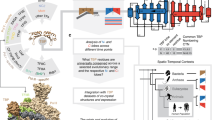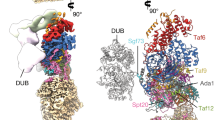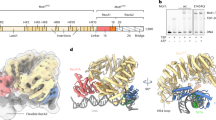Abstract
The three-dimensional structure of a TATA box-binding protein (TBP2) from Arabidopsis thaliana has been refined at 2.1 Å resolution. TBPs are general eukaryotic transcription factors that participate in initiation of RNA synthesis by all three eukaryotic RNA polymerases. The carboxy-terminal portion of TBP is a unique DNA-binding motif/protein fold, adopting a highly symmetric α/β structure that resembles a molecular saddle with two stirrup-like loops. A ten-stranded, antiparallel β-sheet provides a concave surface for recognizing class II nuclear gene promoters, while the four amphipathic α-helices on the convex surface are available for interaction with other transcription factors. The myriad interactions of TBP2 with components of the transcription machinery are discussed.
This is a preview of subscription content, access via your institution
Access options
Subscribe to this journal
Receive 12 print issues and online access
$189.00 per year
only $15.75 per issue
Buy this article
- Purchase on Springer Link
- Instant access to full article PDF
Prices may be subject to local taxes which are calculated during checkout
Similar content being viewed by others
References
Sentenac, A. Eukaryotic RNA polymerases. CRC Crit. Rev. Biochem. 18, 31–90 (1985).
Reeder, R.H. Regulation of transcription by RNA polymerase I. in Transcriptional regulation (eds McKnight, S. & Yamamoto, K.R.) 315–348 (Cold Spring Harbor Laboratory Press, Cold Spring Harbor, New York, 1992).
Roeder, R.G. The complexities of eukaryotic transcription initiation: regulation of preinitiation complex assembly. Trends biochem. Sci. 16, 402–408 (1991).
Zawel, Z. & Reinberg, D. Initiation of transcription by RNA polymerase II: a multi-step process. Prog. nucl. Acids Res. molec. Biol. 44, 67–108 (1993).
Gabrielsen, O.S. & Sentenac, A. RNA polymerase III (C) and its transcription factors. Trends biochem. Sci. 16, 412–416 (1991).
Hernandez, N. TBP, a universal transcription factor? Genes Dev. 7, 1291–1308 (1993).
Gill, G. & Tjian, R. Eukaryotic coactivators associated with the TATA box binding protein. Curr. Opin. Genetics Dev. 2, 236–242 (1992).
Matsui, T., Segall, J., Weil, P.A. & Roeder, R.G. Multiple factors required for accurate initiation of transcription by purified RNA polymerase II. J. biol. Chem 255, 11992–11996 (1980).
Buratowski, S. & Sharp, P.A. Initiation of transcription by RNA polymerase II. in Transcriptional Regulation (eds McKnight, S. & Yamamoto, K.R.) 227–246 (Cold Spring Harbor Laboratory Press, Cold Spring Harbor, 1992).
Buratowski, S., Hahn, S., Guarente, L. & Sharp, P.A. Five intermediate complexes in transcription initiation by RNA polymerase II. Cell 56, 549–561 (1989).
Wang, W., Carey, M. & Gralla, J. Polymerase II promoter activation: closed complex formation and ATP-driven start site opening. Science 255, 450–453 (1992).
Dyke, M.W.V., Roeder, R.G. & Sawadogo, M. Physical analysis of transcription preinitiation complex assembly on a class II gene promoter. Science 241, 1335–1338 (1988).
Ptashne, M. & Gann, A.A.F. Activators and targets. Nature 346, 329–331 (1990).
Wang, W., Gralla, J. & Carey, M. The acidic activator GAL4-AH can stimulate polymerase II transcription by promoting assembly of a closed complex requiring TFIID and TFIIA. Genes Dev. 6, 1716–1727 (1992).
Comai, L., Tanese, N. & Tjian, R. The TATA-binding protein and associated factors are integral components of the RNA polymerase I transcription factor, SL1. Cell 68, 965–976 (1992).
Nikolov, D.B. et al. Crystal structure of TFIID TATA box-binding protein. Nature 360, 40–46 (1992).
Hahn, S., Buratowski, S., Sharp, P.A. & Guarente, L. The TATA-binding protein TFIID binds to TATA elements with both consensus and nonconsensus DNA sequences. Proc. natn. Acad. Sci. U.S.A. 86, 5718–5722 (1989).
Hooper, B.C., LeBlanc, J.F. & Hawley, D.K. Kinetic analysis of yeast TFIID-TATA box complex formation suggests a multi-step pathway. J. biol. Chem. 267, 11539–11546 (1992).
Chasman, D.I., Flaherty, K.M., Sharp, P.A. & Kornberg, R.D. Crystal structure of yeast TATA-binding protein and model for interaction with DNA. Proc. natn. Acad. Sci. U.S.A. 90, 8174–8178 (1993).
Kim, Y., Geiger, J.H., Hahn, S. & Sigler, P.B. Crystal structure of a yeast TBP/TATA-box complex. Nature 356, 512–520 (1993).
Kim, J.L., Nikolov, D.B. & Burley, S.K. Co-crystal structure of TBP recognizing the minor groove of a TATA element. Nature 365, 520–527 (1993).
Klug, A. Opening the gateway. Nature 365, 486–487 (1993).
Kim, J.L. & Burley, S.K. 1.9 Å Refined structure of TBP recognizing the minor groove of TATAAAAG. Nature struct. Biol. 1, 638–653 (1994).
Sibanda, B.L., Blundell, T.L. & Thornton, J.M. Conformation of β-hairpins in protein structures: A systematic classification with applications to modelling by homology, electron density fitting and protein engineering. J. molec. Biol. 206, 759–777 (1989).
Janin, J. & Chothia, C. The structure of protein-protein recognition sites. J. biol. Chem. 265, 16027–16030 (1990).
Hoffmann, A. et al. Highly conserved core domain and unique N terminus with presumptive regulatory motifs in a human TATA factor (TFIID). Nature 346, 387–390 (1990).
Crowley, T.E. et al. A new factor related to TATA-binding protein has highly restricted expression patterns in Drosophila. Nature 361, 557–561 (1993).
McAndrew, M.B., Read, M., Sims, P.F.G. & Hyde, J.E. Characterization of the gene encoding an unusually divergent TATA-binding protein (TBP) from the extremely A+T rich human malaria parasite Plasmodium falciparum. Gene 124, 165–171 (1993).
Bowie, J.U., Luthy, R. & Eisenberg, D. A method to identify protein sequences that fold into a known three-dimensional structure. Science 253, 164–170 (1991).
Cormack, B.P. & Struhl, K. The TATA-binding protein is required for transcription by all three nuclear RNA polymerases in yeast cells. Cell 69, 685–696 (1992).
Schultz, M.C., Reeder, R.H. & Hahn, S. Variants of the TATA-binding protein can distinguish subsets of RNA polymerase I, II, and III promoters. Cell 69, 697–702 (1992).
Cormack, B.P. & Struhl, K. Regional codon randomization: defining a TATA-binding protein surface required for RNA polymerase III transcription. Science 262, 244–248 (1993).
Kim, T.K. & Roeder, R.G. Involvement of the basic repeat domain of TATA-binding protein (TBP) in transcription by RNA polymerase I, II, and III. J. biol. Chem. 269, 4891–4894 (1994).
Reddy, P. & Hahn, S. Dominant negative mutation in yeast TFIID define a bipartite DNA-binding region. Cell 65, 349–357 (1991).
Poon, D. et al. Genetic and biochemical analyses of yeast TATA-binding protein mutants. J. biol. Chem. 268, 5005–5013 (1993).
Buratowski, S. & Zhou, H. A suppressor of TBP mutations encodes an RNA polymerase II transcription factor with homology to TFIIB. Cell 71, 221–230 (1992).
Colbert, T. & Hahn, S. A yeast TFIIB-related factor involved in RNA polymerase III transcription. Genes Dev. 6, 1940–1949 (1992).
Dahmus, M.E. & Kedinger, C. Transcription of Adenovirus-2 major late promoter inhibited by monoclonal antibody directed against RNA polymerase IIA and IIO. J. biol. Chem. 258, 2303–2307 (1983).
Usheva, A. et al. Specific interactions between the nonphosphorylated form of RNA polymerase II and the TATA-binding protein. Cell 69, 871–881 (1992).
Lee, D.K., DeJong, J., Hashimoto, S., Horikoshi, M. & Roeder, R.G. TFIIA induces conformational changes in TFIID via interactions with the basic repeat. Molec. Cell. Biol. 12, 5189–5196 (1992).
Buratowski, S. & Zhou, H. Transcription factor IID mutants defective for interaction with transcription factor IIA. Science 255, 1030–1032 (1992).
Ranish, J.A., Lane, W.S. & Hahn, S. Isolation of two genes that encode subunits of the yeast transcription factor IIA. Science 255, 1127–1129 (1992).
Greenblatt, J. Protein-protein interactions as critical determinants of regulated initiation and termination of transcription. in Transcriptional Regulation (eds McKnight, S. & Yamamoto, K.R.) 203–226 (Cold Spring Harbor Laboratory Press, Cold Spring Harbor, 1992).
Kim, T.K. et al. Effects of activation-defective TBP mutations on transcription inhibition in yeast. Nature, 369, 252–255 (1994).
Zhou, Q., Boyer, T.G. & Berk, A.J. Factors (TAFs) required for activated transcription interact with TATA box-binding protein conserved core domain. Genes Dev. 7, 180–187 (1993).
Yokomori, K., Chen, J.-L., Admon, A., Zhou, S. & Tjian, R. Molecular cloning and characterization of dTAFII30α and dTAFII30β: two small subunits of Drosophila TFIID. Genes Dev. 7, 2587–2597 (1993).
Kokubo, T., Gong, D.-W., Wootton, J.C., Horikoshi, M. & Roeder, R.G. Molecular cloning of Drosophila TFIID subunits. Nature 367, 484–487 (1993).
Weinzierl, R., Ruppert, S., Dynlacht, B., Tanese, N. & Tjian, R. Cloning and expression of Drosophila TAFII60 and human TAFII70 reveal conserved interactions with other subunits of TFIID. EMBO J. 12, 5303–5309 (1993).
Kokubo, T., Yamashita, S., Horikoshi, M., Roeder, R.G. & Nakatani, Y. Interaction between the N-terminal domain of the 230kDa subunit and the TATA box-binding subunit of TFIID negatively regulates TATA box binding. Proc. natn. Acad. Sci. U.S.A. 91, 3520–3524 (1994).
Lee, W.S., Kao, C.C., Bryant, G.O., Liu, X. & Berk, A.J. Adenovirus E1A activation domain binds the basic repeat in the TATA box transcription factor. Cell 67, 365–376 (1991).
Winston, F. & Minehart, P.L. Analysis of the yeast SPT3 gene and identification of its product, a positive regulator of Ty transcription. Nucl. Acids Res. 14, 6885–6900 (1986).
Winston, F. Analysis of SPT Genes: A genetic approach toward analysis of TFIID, histones, and other transcription factors of yeast. in Transcriptional Regulation (eds McKnight, S. & Yamamoto, K.R.) 1271–1293 (Cold Spring Harbor Laboratory Press, Cold Spring Harbor, 1992).
Eisenmann, D.M., Arndt, K.M., Ricupero, S.L., Rooney, J.W. & Winston, F. SPT3 interacts with TFIID to allow normal transcription in Saccharomyces cerevisiae. Genes Dev. 6, 1319–1331 (1992).
Workman, J.L. & Roeder, R.G. Binding of transcription factor TFIID to the major late promoter during In vitro nucleosome assembly potentiates subsequent initiation by RNA polymerase II. Cell 51, 613–622 (1987).
Felsenfeld, G. Chromatin as an essential part of the transcriptional mechanism. Nature 355, 219–224 (1992).
Meisterernst, M. & Roeder, R.G. Family of proteins that interact with TFIID and regulate promoter activity. Cell 67, 557–567 (1991).
Inostroza, J.A., Mermelstein, F.H., Ha, I., Lane, W.S. & Reinberg, D. Dr1, a TATA-binding protein-associated phosphoprotein and inhibitor of class II gene transcription. Cell 70, 477–489 (1992).
Meisterernst, M., Roy, A.L., Lieu, H.M. & Roeder, R.G. Activation of class II gene transcription by regulatory factors is potentiated by a novel activity. Cell 66, 981–993 (1991).
Cortes, P., Flores, O. & Reinberg, D. Factors involved in specific transcription by mammalian RNA polymerase II: purification and analysis of transcription factor IIA and identification of transcription factor IIJ. Molec. Cell. Biol. 12, 413–421 (1992).
Drapkin, R., Merino, A. & Reinberg, D. Regulation of RNA polymerase II transcription. Curr. Opin. Cell Biol. 5, 469–476 (1993).
Kelleher, III, R.J. et al. Yeast and human TFIIDs are interchangeable for the response to acidic transcriptional activators in vitro. Genes Dev. 6, 296–303 (1992).
Berk, A.J. Adenovirus E1A trans-activation: Understanding it Will Require learning how the general transcription factors function. in Transcriptional Regulation (eds McKnight, S. & Yamamoto, K.R.) 727–742 (Cold Spring Harbor Laboratory Press, Cold Spring Harbor, 1992).
Horikoshi, N., et al. Direct interactions between Adenovirus E1A protein and the TATA box binding transcription factor IID. Proc. natn. Acad. Sci. U.S.A. 88, 5124–5128 (1991).
Kerr, L.D. et al. Association between proto-oncoprotein rel and TATA-binding protein mediates transcriptional activation by NF-kB. Nature 356, 412–419 (1993).
Keaveney, M., Berkenstam, A., Feigenbutz, M., Vriend, G. & Stunnenberg, H.G. Residues in the TATA-binding protein required to mediate a transcriptional response to retinoic acid in EC cells. Nature 365, 562–566 (1993).
Caron, C. et al. Functional and biochemical interaction of the THLV-1 TAX1 transcactivatorwith TBP. EMBO J. 12, 4269–4278 (1993).
Hagemeier, C., Walker, S., Caswell, R., Kouzarides, T. & Sinclair, J. The human cytomegalovirus 80-kilodalton but not the 72-kilodalton immediate-early protein transcactivates heterologous promoters in a TATA box-dependent mechanism and interacts directly with TFIID. J. Virol. 66, 4452–4456 (1992).
Lieberman, P.M. & Berk, A.J. The Zta trans-activator protein stabilizes TFIID association with promoter DMA by direct protein-protein interaction. Genes Dev. 5, 2441–2454 (1991).
Stringer, K.F., Ingles, C.J. & Greenblatt, J. Direct and selective binding of an acidic transcriptional activation domain to the TATA-box factor TFIID. Nature 345, 783–786 (1990).
Martin, D.W., Munoz, R.M., Subler, M.A. & Deb, S. p53 binds to the TATA-binding protein-TATA complex. J. biol. Chem. 268, 13062–13067 (1993).
Seto, E. et al. Wild-type p53 binds to the TATA-binding protein and represses transcription. Proc. natn. Acad. Sci. U.S.A. 89, 12028–12032 (1992).
Truant, R., Xiao, H., Ingles, C.J. & Greenblatt, J. Direct interaction between the transcriptional activation domain of human p53 and the TATA box-binding protein. J. biol. Chem. 268, 2284–2287 (1993).
Ragimov, N. et al. Wild-type but not mutant p53 can repress transcription initiation in vitro by interfering with the binding of basal transcription factors to the TATA motif. Oncogene 8, 1183–1193 (1993).
Liu, X., Miller, C.W., Koeffler, P.H. & Berk, A.J. p53 activation domain binds TATA-box-binding polypeptide and a neighboring p53 domain inhibits transcription. Molec. Cell. Biol. 13, 3291–3300 (1993).
Chen, X., Farmer, G., Zhu, H., Praywes, R. & Prives, C. Cooperative DNA binding of p53 with TFIID (TBP): a possible mechanism for transcriptional activation. Genes Dev. 7, 1837–1849 (1993).
Katagiri, F. & Chua, N.-H. Plant transcription factors: present knowledge and future challenges. Trends Genet. 8, 22–27 (1992).
Brunger, A.T. XPLOR Manual (Yale University, New Haven, 1992).
Luzzati, P.V. Traitement statistique des erreurs dans la determination des structures cristallines. Acta. crystallogr. 5, 802–810 (1952).
Ramachandran, G.N. & Sasisekharan, V. Conformation of polypeptides and proteins. Advan. Prot. Chem. 23, 283–437 (1968).
Luthy, R., Bowie, J.U. & Eisenberg, D. Assessment of protein models with three-dimensional profiles. Nature 356, 83–85 (1992).
Kraulis, P.J. Molscript: a program to produce both detailed and schematic plots of protein structures. J. Appl. Crystallogr. 24, 946–950 (1991).
Nicholls, A., Sharp, K. & Honig, B. Protein folding and association: insights from the interfacial and thermodynamic properties of hydrocarbons. Proteins 11, 281–296 (1991).
Gilson, M., Sharp, K. & Honig, B. Calculating the electrostatic potential of molecules in solution: method and error assessment. J. comput. Chem. 9, 327–335 (1988).
Kim, S.S., Hong, Y. & Kang, C. Effects of multiple mutations at the conserved TATA sequence of bacteriophage SP6 promoter on transcription efficiency. Biochem. molec. Biol. Internatl. 31, 153–159 (1993).
Xu, X. et al. Functional interaction of the v-rel and c-rel oncoproteins with the TATA-binding protein and association with TFIIB. Molec. Cell. Biol. 13, 6733–6741 (1993).
Gasch, A., Hoffmann, A., Horikoshi, M., Roeder, R.G. & Chua, N.-H. Arabidopsis thaliana contains two genes for TFIID. Nature 346, 390–394 (1990).
Haass, M.M. & Feix, G. Two different cDNA encoding TFIID proteins of maize. FEBS Lett. 301, 294–298 (1992).
Holdsworth, M.J., Grierson, C., Schuch, W. & Bevan, M. DNA-binding properties of cloned TATA-binding protein from potato tubers. Plant molec. Biol. 19, 455–464 (1992).
Kawata, T., Minami, M., Tamura, T.-a., Sumita, K. & Iwabuchi, M. Isolation and characterization of a cDNA clone encoding the TATA•box-binding protein (TFIID) from wheat. Plant molec. Biol. 19, 867–872 (1992).
Apsit, V., Freeberg, J.A., Chase, M.R., Davis, E.A. & Ackerman, S. Wheat TFIID TATA binding protein. Nucl. Acids Res. 21, 1494 (1993).
Fikes, J.D., Becker, D.M., Winston, F. & Guarente, L. Striking conservation of TFIID in Schizosaccharomyces pombe and Saccharomyces cerevisiae. Nature 346, 291–294 (1990).
Hoffmann, A. et al. Cloning of the Schizosaccharomyces pombe TFIID gene reveals a strong conservation of functional domains present in Saccharomyces cerevisiae TFIID. Genes Dev. 4, 1141–1148 (1990).
Horikoshi, M. et al. Cloning and structure of a yeast gene encoding a general transcription initiation factor TFIID that binds to the TATA box. Nature 341, 299–303 (1989).
Cavallini, B. et al. Cloning of the gene encoding the yeast protein BTF1Y, which can substitute for the human TATA box-binding factor. Proc. natn. Acad. Sci. U.S.A. 86, 9803–9807 (1989).
Hahn, S., Buratowski, S., Sharp, P.A. & Guarente, L. Isolation of the gene encoding the yeast TATA binding protein TFIID: A gene identical to the SPT15 suppressor of Ty element insertions. Cell 58, 1173–1181 (1989).
Schmidt, M.C., Kao, C.C., Pei, R. & Berk, A.J. Yeast TATA-box transcription factor gene. Proc. natn. Acad. Sci. U.S.A. 86, 7785–7789 (1989).
Hoey, T., Dynlacht, B.D., Peterson, M.G., Pugh, B.F. & Tjian, R. Isolation and characterization of the Drosophila gene encoding the TATA box binding protein, TFIID. Cell 61, 1179–1186 (1990).
Muhich, M.L., Iida, C.T., Horikoshi, M., Roeder, R.G. & Parker, C.S. cDNA clone encoding Drosophila transcription factor TFIID. Proc. natn. Acad. Sci. U.S.A. 87, 9148–9152 (1990).
Kao, C.C. et al. Cloning of a transcriptionally active human TATA binding factor. Science 248, 1646–1650 (1990).
Peterson, M.G., Tanese, N., Pugh, B.F. & Tjian, R. Functional domains and upstream activation properties of cloned human TATA binding protein. Science 248, 1625–1630 (1990).
Wong, J., Liu, F. & Bateman, E. Cloning and expression of the Acanthamoeba castellanii gene encoding transcription factor TFIID. Gene 117, 91–97 (1992).
Li, S. & Donelson, J.E. The gene for the TATA box-binding protein of Onchocerca volvulus. Molec. Biochem. Parasitol. 61, 321–324 (1993).
Lichtsteiner, S. & Tjian, R. Cloning and properties of the Caenorhabditis elegans TATA-box binding protein. Proc. natn. Acad. Sci. U.S.A. 90, 9673–9677 (1993).
Stargell, L.A. & Gorovsky, M.A. TATA-binding protein and nuclear differentiation in Tetrahymena thermophila. Molec. cell. Biol. 14, 723–734 (1994).
Author information
Authors and Affiliations
Rights and permissions
About this article
Cite this article
Nikolov, D., Burley, S. 2.1 Å resolution refined structure of a TATA box-binding protein (TBP). Nat Struct Mol Biol 1, 621–637 (1994). https://doi.org/10.1038/nsb0994-621
Received:
Accepted:
Issue Date:
DOI: https://doi.org/10.1038/nsb0994-621
This article is cited by
-
Structural basis of the complete poxvirus transcription initiation process
Nature Structural & Molecular Biology (2021)
-
Molecular Mechanisms and Therapeutics for SCA17
Neurotherapeutics (2019)
-
Piperine ameliorates SCA17 neuropathology by reducing ER stress
Molecular Neurodegeneration (2018)
-
Role of indirect readout mechanism in TATA box binding protein–DNA interaction
Journal of Computer-Aided Molecular Design (2015)
-
TBP-related factors: a paradigm of diversity in transcription initiation
Cell & Bioscience (2011)



